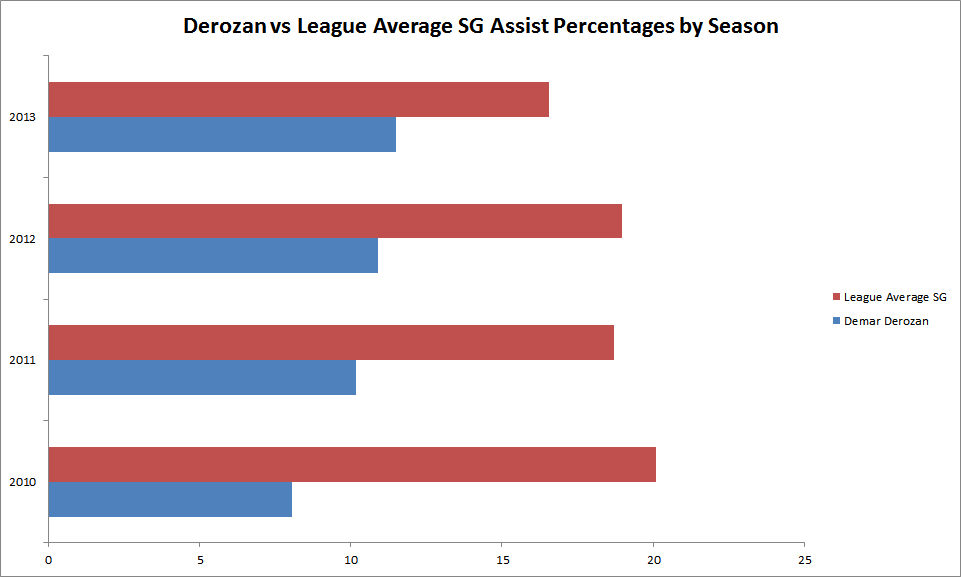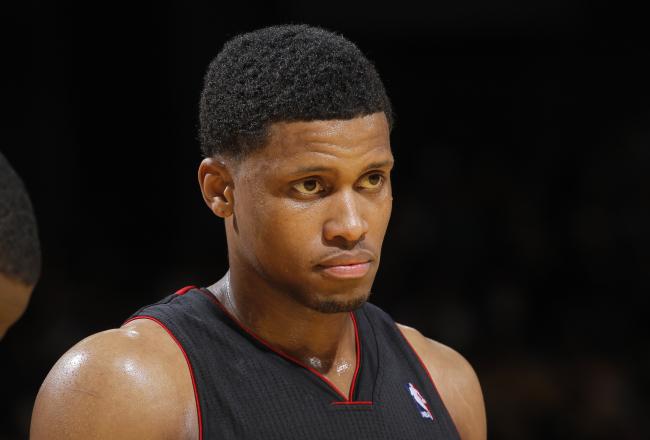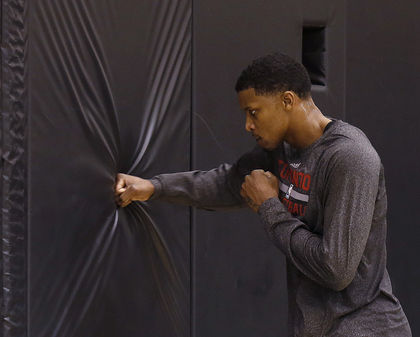An in-depth look at Demar’s passing game, flush with statistics and video breakdowns.
The conversation about Demar Derozan always starts and ends with three things; his post-game, his contract and his inability to sink a three-pointer. But with the Raptors employing such a wing-heavy offense, why doesn’t anyone talk about his passing game?
The obvious answer is that Demar doesn’t produce very many assists. His career high came last season when he dropped a mere 2.5 dimes per game. That’s not very good for a guy who played almost 37 minutes per game last season. His assist rates (% of made baskets assisted by Demar) haven’t been so hot either:
However, low assist figures doesn’t mean Demar can’t/won’t pass – there are also contextual factors to consider. Demar is the finisher on most plays and he’s not really tasked with the responsibility of creating for his teammates. This suppresses both his assist rate (because he can’t assist on his own baskets) and assists per game (because that’s not his role). It’s a classic case of “the numbers don’t tell the whole story.”
More importantly, the question shouldn’t be “is Demar a good/bad passer?” That’s far to simplistic. Rather, the question I wanted to answer is “what passes can Demar make?” With that in mind, I dove into the synergy sports video archives to find my answer, and I came up with two areas of note: passes in transition, and passes on drive-and-kick plays.
Passes in Transition
With the help of Louvens Remy, video production wizard and loyal Raptors Republic reader, I was able to provide a TL;DR solution for the post. Presented below is a video “tele-stration” breakdown of Derozan passing in transition:
As you can see from the video above, Demar is a capable passer in transition. He’s usually the finisher on the fast break, where he uses his elite athleticism to score at a rate of 1.23 points per transition play (80th percentile in NBA), but he also has a bit of creativity. Over his four-year career in the NBA, Demar has tightened up his dribble and developed new moves which have allowed him to harness his athleticism. By no means am I suggesting that he’s now got Kyrie Irving’s handles or anything, but the ability to pass makes him far more dangerous than your prototypical finisher on the fast break.
Listed below are two more examples:
His court-awareness on the fast-break is crucial for the Toronto Raptors. Last season the Raptors scored a measly 9.9 points in transition per game, which ranked 26th in the NBA. Yes, a lot of that has to do contextual factors like the efficacy of Toronto’s defense (22nd in DefEff), defensive rebounding rate (16th in the NBA) and pace (23rd), but Toronto clearly failed to maximize the athleticism of their wings.
If Demar is able to shoulder more ball-handling responsibilities on the Raptors’ fast breaks, the team would be less reliant on getting the ball to Lowry before they can break out. Opposing defenses would presumably key in on stopping Demar from getting to the basket (see the aforementioned clips), which should theoretically leave Raptors’ teammates open for layups or jumpshots.
Drive and Kick
Demar is also capable of drawing extra defenders on his drives and finding the open shooters. Once again, with Louvens’ help, here is your TL;DR option:
I discussed Demar’s improved handles in the previous section and how it has allowed him to be effective in fast-break scenarios, but his ability to break down defenders is also key in half-court sets. Last season, Demar averaged 0.87 points per play as the pick-and-roll ball-handler which ranked 30th overall in the NBA. As you can see from the video above, as well as the video below, Demar’s preferred option is to drive into the paint before deciding to attack the rim or to find the open man. Either way, opposing defenders are forced to step up and stop his drive, which distorts the shape and configuration of opponent defenses, thereby creating opportunities for Demar’s teammates.
However, Demar is also able to create in other scenarios, namely in isolation, and more recently, from the post. In the clip below, Demar is able to beat his man, draw the help defender and kick it out to an open Kyle Lowry on the perimeter:
Similarly, he’s also capable of passing from the post. If he’s paired with a knock-down shooter like Steve Novak, opposing defenses will face a difficult decision in whether to allow Demar to attack one-on-one, or to leave Novak to double-down in the post.
Conclusion
Despite posting sub-par assist numbers, Demar is a capable passer in certain scenarios, namely in drive-and-kick scenarios and on the fast break. However, capable and willingness are two things (seriously, 24%+ USG, 12% AST%?), and he is undoubtedly lacking in the latter.
If the plan going forward is to have the offense run through Demar, be it in the post or in pick-and-roll situations, Demar has at least shown the ability to make correct decisions and decent passes in these scenarios, especially in transition and on drive-and-kicks.
Lastly, I would like to offer my sincerest gratitude to Louvens Remy for helping out with collecting the highlights used in this clip and for putting together the two telestrations in the post. Thanks for volunteering your time, offering your feedback on the post itself, and lastly, for putting up with my comically hurried narration. If you ever need guy for putting together a video project or two, drop Louvens a line at @LouvensRemy and make sure to check out his excellent work over at Black Sunrise Pictures.
Statistical support from Hoopdata, NBA Stats, Synergy Sports and Basketball-Reference.




